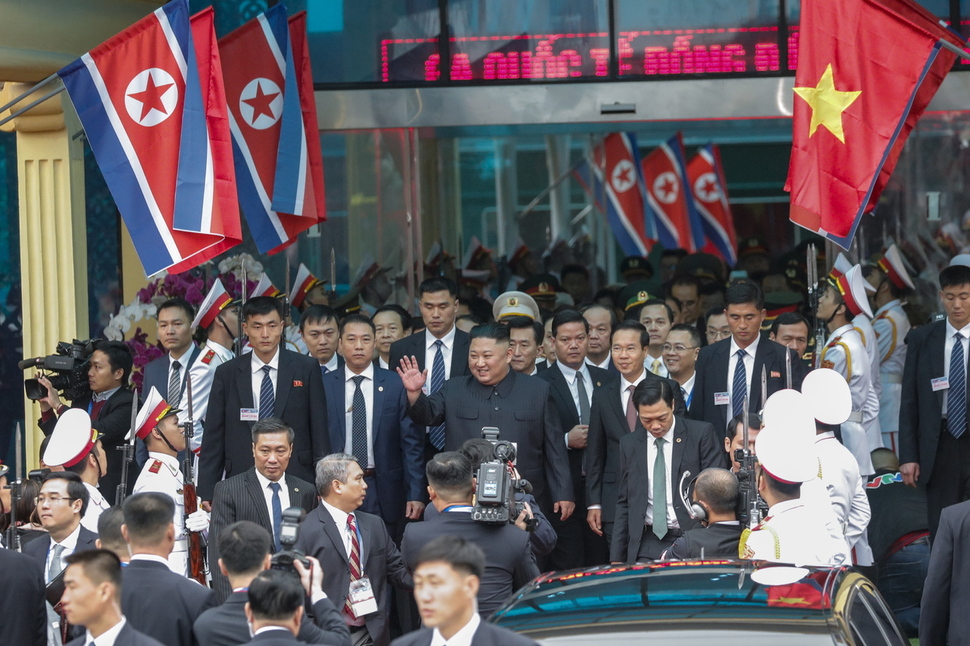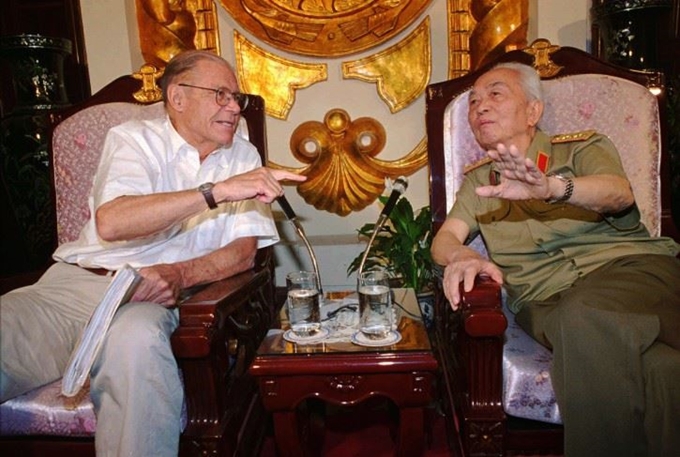 |
|
North Korean leader Kim Jong-un arrives at Dang Dong station in Vietnam’s Lang Son Province on Feb. 26. (EPA/Yonhap News)
|
The Hanoi summit represents a major milestone, but the road to peace is a long one
US President Donald Trump and North Korean leader Kim Jong-un first met on June 12, 2018. The encounter came 25,469 days after North Korea came into existence as half of a divided nation. Now, 260 days after the Singapore summit, the two leaders are meeting for a second time on Feb. 27, 2019.
The difference between those two numbers - 25,469 days to 260 – reflects the historical importance and magnitude of the second North Korea-US summit as an event poised to shape the fate of peace on the Korean Peninsula. The second summit came about much more easily than the first; it required just 1% of the period taken to achieve that first encounter. At the same time, 260 days is also a grossly inadequate amount of time to dispel all the mistrust and antagonism that has built up over 25,469 days, 1,128 of which were spent fighting a war. As war, hostility and conflict drag on, reconciliation and peace become more distant prospects. This is why it is so essential to avoid an “all or nothing” attitude; there is still a lot of road to travel.
The second summit is taking place in the Vietnamese capital of Hanoi. As a city, Hanoi offers historical proof that the path from war to peace and from antagonism to reconciliation and coexistence is not completely blocked. What about the Sofitel Legend Metropole Hanoi hotel, which has reportedly been selected as the summit venue? In its basement is the air-raid shelter where singer Joan Baez once hid on Christmas Eve 1972 as US shell rained down from the night skies over Hanoi. In the shelter of what was then known as the Thong Nhat (Reunification) Hotel, Baez sang over and over the lyrics of “We Shall Overcome,” an anthem among opponents of the US’ invasion of Vietnam.
The Metropole hotel is a historical witness to a war marked by invasions and resistance that claimed countless lives, and to the painful struggles of reconciliation and reflection. It is also the setting of the first “dialogue with the enemy,” where Robert McNamara, who designed and executed the invasion of Vietnam as US Secretary of Defense from 1961 to 1968, sat down with former Vietnamese Foreign Minister Nguyen Co Thach to examine why they had ended up drawn into the war and why it could not be ended sooner – investigating the “missed opportunity” in order to prevent another such mistake from happening again.
 |
|
Robert McNamara, who served as US Secretary of Defense from 1961 to 1968, sat down with former Vietnamese Foreign Minister Nguyen Co Thach in November 1995 in Hanoi to discuss the Vietnam War. (provided by Wonderbox)
|
McNamara discerned two main lessons from the first dialogue on June 20–23, 1997: understand your opponent, and continue to engage in dialogue with the other side’s top leader, even if they are an “enemy.” Kim and Trump seem to made concerted efforts to follow McNamara’s lesson. With their second meeting, the North Korean and US leaders are looking forward to parlaying the results of their first summit into a major step toward normal relations.
Predictions have been a mixture of optimism and pessimism. To begin with, progress in implementing the Singapore agreement – the joint statement produced in Singapore last June 12 after the two leaders of 70-year adversaries met for a “comprehensive, in-depth, and sincere exchange of opinions” – has been paltry. After the first summit, Kim had the remains of 55 US troops from the Korean War repatriated and took basic steps toward the permanent dismantlement of the missile engine testing and launch sites at Tongchang Village. The US opened the door – very slightly – toward the end of the year for aid to North Korea by international humanitarian groups, which had previously been blocked by sanctions. That’s about it.
Eliminating the four pillars of hostility on the Korean Peninsula
But the Singapore agreement, and its vision for bringing the Cold War on the Korean Peninsula to a close, has not been abandoned. It lives on – which is why we should be on guard against premature pessimism. The Korean Peninsula is a tragic land, swirling with the deeply rooted hostility and conflict of what South Korean President Moon Jae-in called the “world’s last remaining Cold War system.” Like a bamboo forest, the Cold War system on the peninsula is held up by four intertwined pillars: the relationship of antagonism and mistrust between South and North, the hostile relations between North Korea and the US (which is deeply involved in peninsula issues), North Korea’s pursuit of nuclear armament to ensure its regime’s survival and establish a deterrent, and the perpetuation of the military armistice system and associated arms race that form the root of the hostility.
“These elements are mutually interdependent, and we can’t separate out any one of them for resolution,” said former Unification Minister and honorary chairman of the Korea Peace Forum Lim Dong-won, who designed and carried out the early Korean Peninsula Peace process.
“You have to approach things comprehensively for there to be a fundamental resolution to Korean Peninsula issues,” he advised.
The agreement that the leaders of North Korea and the US signed in Singapore was a promise to eliminate three of these four pillars. Resetting North Korea-US relations (the first term of the agreement) corresponds to the second pillar, a joint effort to build a strong and lasting peace regime (the second term) corresponds to the fourth pillar, and striving toward complete denuclearization of the Korean Peninsula (the third term) corresponds to the third pillar. Work on dismantling the fourth pillar has already begun through implementation of the Panmunjom Declaration (Apr. 27, 2018), the Pyongyang Joint Declaration (Sept. 19, 2018), and the Comprehensive Military Agreement (Sept. 19, 2018). South and North Korea are also working together to topple the second, third and fourth pillars. If the Singapore agreement and the inter-Korean summit declarations are completely implemented, the four pillars of the Cold War alignment on the Korean Peninsula will become the foundation for peace, just as ice melted by the spring rains nourishes new life. There’s a critical need for the leaders of South Korea, North Korea and the US to move forward in unison, like three runners in a four-legged race.
The most important thing is that Kim and Trump have abided by their Singapore agreement in the face of various pressures and temptations. Despite their completely different worldviews and interests, optimists and pessimists agree on one thing: the goal of Kim and Trump’s second sit-down is to create a concrete plan for implementing the four points agreed to in Singapore. That in itself is the huge achievement of the 260 days since their first meeting. If the train of peace is derailed, it will never reach its destination.
 |
|
President Donald Trump meets Vietnamese President Nguyen Phu Trong at the Presidential Palace, Wednesday, Feb. 27, 2019, in Hanoi. (AP)
|
The essential role of S. Korea and Moon Jae-in as mediator
During their first meeting, Kim and Trump confirmed that mutual confidence-building can bring about progress toward the denuclearization of the Korean Peninsula. But distrust runs deep and confidence remains shallow. Shortly after the first North Korea-US summit, US Secretary of State Mike Pompeo traveled to Pyongyang carrying an “empty briefcase” and pressured the North Koreans to reports all if its nuclear facilities. North Korea complained that Pompeo had made “gangster-like demands.” But just when the Singapore agreement was sinking into the swamp of distrust, it was salvaged by South Korean President Moon Jae-in, the mediator. That salvation came in the form of the Pyongyang Joint Declaration that September, which contained Kim’s promise to “continue to take additional measures, such as the permanent dismantlement of the nuclear facilities in Yongbyon, as the United States takes corresponding measures.” A trustworthy third party is a necessary catalyst for resolving hostility.
More time is needed for Americans, with their fantasies of exceptionalism, to come down to earth and for the North Koreans to set aside their fear of an invasion by the “American imperialist wolves” and climb up to the surface from underground. It took the arrival of the New Year to open up the time and space for opportunity. The US has treated the North as a rational actor, and the North has attempted to play by the American rules for dialogue.
While US State Department Special Representative for North Korea Stephen Biegun has acknowledged that the US and North Korea have “dramatically different views on individual rights and on human rights” and “different worldviews about the region and about each other,” he hasn’t criticized North Korea as being a gangster state like other US officials have. Furthermore, Biegun said during a lecture at Stanford on Jan. 31 that the US is “prepared to pursue – simultaneously and in parallel – all of the commitments our two leaders made in their joint statement at Singapore last summer.”
“Simultaneously and in parallel” is the implementation principle that the North Koreans have advocated to push back against the US demand for North to denuclearize first. Kim Jong-un informed the US that the North’s new envoy for negotiations, Kim Hyok-chol, had been given the title “special representative for US affairs” to match Biegun’s title of “special representative for North Korea.”
The efforts to build mutual trust could be a strong driving force for the implementation of the Singapore agreement. But they’re still too weak. The important thing is that the two sides are plowing the fields so that they can sow the seeds of confidence in the frozen soil of distrust.
First step in enemies becoming friends is to treat each other like strangers
An enemy cannot become a friend all at once – that involves a long and painful process. In his book, “How Enemies Become Friends: The Sources of Stable Peace,” Charles Kupchan, senior fellow at the US Council on Foreign Relations, outlines the following steps: unilateral good-will gestures, mutual restraint, deepening exchange and cooperation, and the creation of new narratives and identities. For enemies to become friends, they first need to learn how to treat each other like strangers. That means not resorting to military force despite conflicting plans and remaining courteous despite being self-interested — in other words, the normal relationship between states that is frequently seen in the world. Hopefully, Kim and Trump’s second summit will be a chance for North Korea and the US to take a big step toward putting their long-standing hostility behind them and treating each other like strangers.
By Lee Je-hun, senior staff writer
Please direct comments or questions to [english@hani.co.kr]











